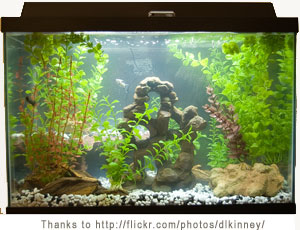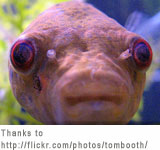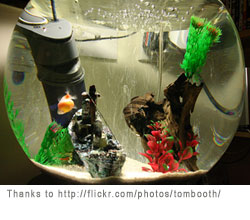Tropical Aquarium Maintenance

Because a tropical fish aquarium is a closed system, it cannot run forever on its own without maintenance.
Nitrate and phosphate build up over time, the water hardness is ever increasing because of evaporation, and if there's allot of fish waste the pH is decreasing. The end result will always be unfavorable water conditions for the fish.
All freshwater aquariums require a 25% water change at least once a month, if you want the ultra clean Las Vegas show tank look, than your going to need to do a 25% water change every week or two depending on how heavily stocked your aquarium is.
Always use a gravel cleaner when doing a water change. This way all of the decomposing organic matter that has built up in the gravel is removed.
Almost all the possible problems that can occur with a tropical fish tank come down to one cause, decomposing organic matter in the aquarium. So obviously removing it will benefit the fish and improve the overall look of the tank. Cleaning your fish tank is very important.
Tropical Fish Tank Water Change Instructions:
Step 1: Check to make sure your aquarium heater will be low enough in the water when you do your water change. If not, unplug the heater, this will prevent your heater from cracking and you from possibly getting shocked. Unplug the fish tank filter and we also recommend unplugging the heater just to be safe. leave your fish in the tank as it causes too much stress to remove them. If you have any snails or frogs, remove them because you could easily harm then while you clean the gravel with the siphon.
Step 2: Using an algae pad, algae magnet, or algae scraper remove any algae that has accumulated on the glass. Do this before removing the water so that you can remove the floating algae particles with the siphon, preventing the aquarium algae from spreading too much.
Step 3: If the aquarium has plastic plants and ornaments and you wish to clean them then remove them. Soaking the plants is a plastic plant cleaner removes and difficult algae build up. This way the plants come out looking brand new and they won't get damaged. If you want to scrub the algae build up off with your fingers, this works fine too. Never wash them with soap because you will add phosphates in your water and cause an algae bloom! If you have live aquarium plants, do not remove them from your tank as you will up-root and could kill them or hinder their growth.
Step 4: Using a gravel cleaner that you have purchased from your local tropical fish store, remove 25 % of the water while cleaning the gravel. Be sure to siphon the gravel throughout the tank. If you have removed the aquarium ornaments, this will allow you to quickly siphon the gravel in the aquarium without removing too much water. We recommend removing the ornaments before siphoning, it makes it easier for you. If you have live plants, be careful when siphoning around the plants as not to disturb or tear the roots.
Step 5: Rinse the filter media in the dirty water that you just removed from your aquarium. Why? If the filter media is rinsed under tap water the beneficial bacteria will be killed from the chlorine in the tap water. Put the filter media back into the fish tank filter, but do not turn it on yet. Never change your filter at the same time you change the water because you will remove too much beneficial bacteria, reducing any natural biological filtration. this could easily shock your fish and can cause disease out break caused by too much stress.
Step 6: If you removed plants or decorations add them back into the aquarium and arrange as desired.
Step 7: Fill a bucket with tap water (don't forget to make sure the temperature is the same as your aquarium, test with your thermometer) and add water conditioner to remove the choline from the water. If you use salt in your fish tank, add the appropriate amount of salt for the amount of water that you removed from the tank, the instructions are on the bottle of aquarium salt.
Step 8: Fill the aquarium back up slowly as not to disturb the fish and to prevent the ornaments from floating about. Place your snails and amphibians (frogs) back into the fish tank.
Step 9: Plug in the heater and plug in the filter. If you have a hang-on the back aquarium filter, you may need to place a few cups of water from the tank into the filter to get the motor siphoning up the water.
Saltwater Fish Tank Water Change
Changing the water in a saltwater aquarium is the same as above, with a few differences:
- Do not remove your live rock or corals from the aquarium.
- Unplug the UV sterilizer, filter, heater and protein skimmer. (Goes with step 1)
- Clean out the cup in the protein skimmer with the foam by rinsing it out under tap water. (Goes with step 5)
- Mix salt solution and measure with a hydrometer to make sure the salt concentration is the same. (Goes with step 7)
Every other step should be followed the same way as the tropical fish water change as above. Also be more careful when siphoning the bottom of the aquarium because it is easy to suck up too much sand because it is very light. Also be cautious with the fish as mist are sensitive to stress. Another difference is that saltwater aquarium water should be changed more often then freshwater aquarium water. marine fish tanks need their water changed every 2 weeks.
Changing the Water in a Fish Bowl
 Never change all of the water in your fish bowl at once, only change up to 50% of the water. If you change all of the water, you will shock your fish when it is immediately submersed in clean water from dirty water.
Never change all of the water in your fish bowl at once, only change up to 50% of the water. If you change all of the water, you will shock your fish when it is immediately submersed in clean water from dirty water. Never wash the rocks or gravel in the bottom of the bowl with soap because you will kill the beneficial bacteria that thrives on the surface of the gravel. This bacteria helps to eliminate nitrate in the water.
If you experience algae problems, rub the gravel and ornaments with your finger to get the algae off. If you need to scrub the rocks, use the old water from the bowl. Fresh tap water will kill the bacteria on the rocks.
Do a water change in your fish bowl once a week.
To clean a fish bowl follow these steps:
Step 1: Remove any ornaments and then remove your fish and and put it in a separate cup with the old water.
Step 2: Swish the bowl to stir up the waste on the bottom. Pour out half of the water and then fill it up with tap water that is the same temperature as the water in the bowl.
Step 3: Add a few drops of dechlorinator (water conditioner) and then put back your ornaments and then finally your fish.
For Frequently Asked Questions about Tropical Fish, click the link!